Is AI tech good enough for bike fitting? I had both an AI and an ‘in-person’ bike fit at my local shop - here’s how they differed
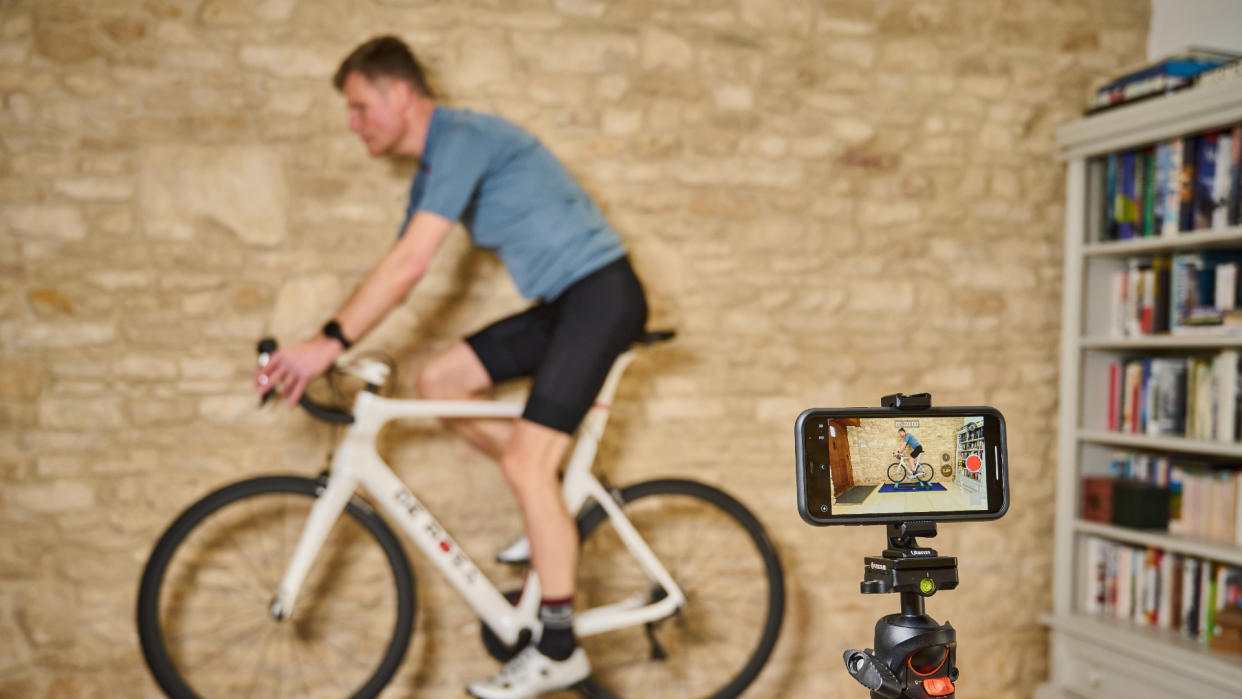
After decades of promise but little credible achievement, artificial intelligence has got very clever very quickly, catching the world off-guard. No longer the preserve of sci-fi movies, AI is here to stay, if not here to take over. Powerful, liberating, accurate and, well, intelligent, it impresses and intimidates in equal measure. In the world of cycling, it promises to calculate our optimum set-up at the click of a button.
In fact, AI bike-fitting has been available since 2021 in the shape of MyVeloFit.com, an online service that promises a virtual fit for less than the cost of a pack of premium bar tape. It’s so inexpensive that I thought it must be worth a gamble. Not too daring a gamble, admittedly, as I also booked a fit at my local bike shop for a human comparison. Cost-wise, they are poles apart: MyVeloFit is one-sixth of the cost of my chosen human bike-fitter. But which offers better value?
AI bike fit versus bike fitter
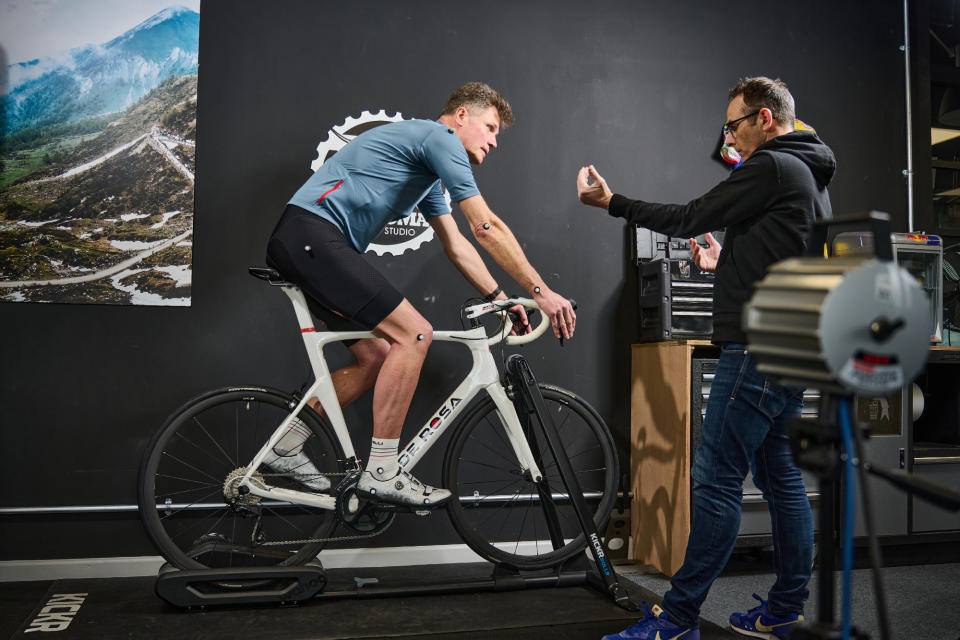
If the power of AI is to be challenged, Grant Bayton is the human for the job. An ex-pro and son of 1980s cycling legend Phil Bayton, Grant’s been around bikes and riders all his life. I found him through my local bike shop, Ride 24/7 in Cirencester, which leans towards the premium market. Owner Dave Evans is as passionate about his customers as he is his bikes. The coffee’s great too.
Meanwhile, MyVeloFit is a young Canadian company co-founded by experienced bike-fitter Jesse Jarjour, with investment and mentorship from Shopify’s former chief technology officer Cody Fauser, himself an avid cyclist. Their aim is to democratise bike-fits, making comfort and performance available to everyone. Will its raison d’être render human bike-fitters obsolete?
I had just the candidate to find out: a barely ridden pearlescent white 2019 De Rosa SK Pininfarina that I’d built up as a lockdown project but never really finished. The noseless ISM saddle is unusual, the FSA carbon cockpit is fixed, the pedals are SPD cast-offs and the carbon steerer remains long because I was too nervous to cut it shorter.
AI bike fit: MyVeloFit
Signing up for MyVeloFit couldn’t be easier. Opt for the $35 (£28) subscription and you’ll be able to fit a single bike to one rider over a period of two weeks. If you own a garage full of bikes, the annual ‘unlimited’ $75 (£60) sub is probably a better choice.
First, the software asks for some basic vital statistics – age, gender, height and so on – in order to build your profile. A simple mobility assessment completes the process, achieved by shooting two videos of yourself holding a variety of simple poses, such as a squat and a knee raise.
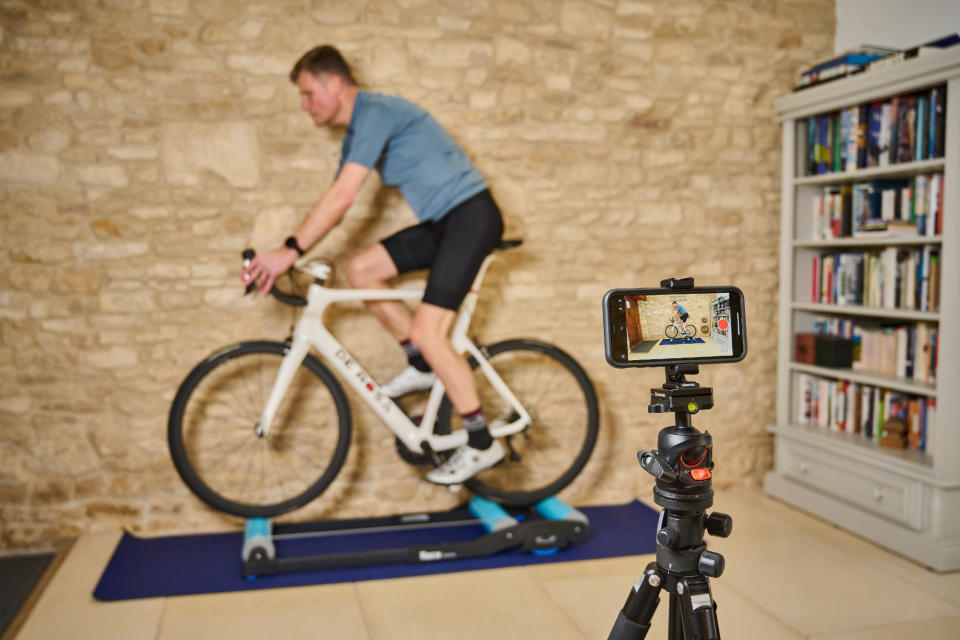
This is the nuts and bolts of MyVeloFit. You upload a video of yourself riding or doing some basic exercises, and it then analyses your content before providing feedback and recommendations. Using your phone, you can upload video directly within MyVeloFit, but because my efforts required the odd re-shoot, I preferred trimming the clips on my laptop first. Either way, the process is straightforward.
Fits are available for road, gravel, mountain, triathlon, hybrid, TT and spin exercise bikes, so naturally I chose ‘road’. MyVeloFit then presents three additional options that vary the aggressiveness of your riding position, ‘performance’, ‘performance & comfort’, and ‘comfort’. Despite the De Rosa’s racing heritage, I’ll be using it for cafe rides, so I selected the middle option.
Once your profile is built, and MyVeloFit has an idea of what your body is both capable of and expecting, it’s time to start the bike-fit proper. All that’s needed is your phone, a static trainer of some sort, the bike and a large space with an uncluttered background.
I prefer to ride bike rollers for indoor cycling and usually confine myself to the hall, but I found that I needed about nine feet of distance between me and the phone to capture a full side-on view, so be warned – even if you train in a large but cluttered garage, you may struggle. In the end, I set up in our living room, the only place large enough with a decent stretch of bare wall. This meant moving a couple of sofas and a coffee table. It was a bit of a faff that I wouldn’t choose to repeat.
The software needs only a 15-second video clip to analyse, all of it ridden on the hoods. The rider must be as relaxed as possible (not ideal for a self-conscious rider on rollers), with arms slightly bent and pedalling at a natural cadence.
Uploading the video is child’s play, and it takes MyVeloFit about five minutes to analyse. The results are impressive. The motion capture software successfully recognises key joints – ankle, knee, hip, shoulder, elbow and wrist – and plays back your video with the familiar superimposed animated ‘stickman’ common to most bike-fit software.
Four stills from the clip are displayed too, capturing overall positioning, stance when at the top of the pedal stroke, the front of the pedal stroke (midway) and the bottom of the pedal stroke. Under each are key stats that include knee extension, hip-open angle, hip-close angle and back angle, together with their acceptable ranges based on your mobility assessment and desire for comfort vs performance.
If all is good, then these measurements will be displayed in green, but if something is awry they’ll be amber, or worse, red. My initial results featured some green, but the majority looked like I’d run into roadworks on the North Circular, lots of amber and red. For example, my knee extension should have been somewhere between 35 and 40°, but it flashed up red at 34°, meaning it was too open.
These colourful stats look impressive, but if you don’t know your flexion from your extension, don’t worry, as MyVeloFit provides step-by-step guidance. It’s a case of making the proposed adjustments, shooting another video, then repeating the process until all the figures turn green.
My open knee meant I was instructed to lower my saddle, which also brought my shoulder angle into the acceptable range but threw my back angle into the red. What’s more, based on feel, I was expecting my saddle to go higher, not lower, which shook my confidence in the process. In the end, I went through six cycles of videoing, uploading, analysing, adjusting and head-scratching before most of the figures were green with just a hint of red as my shoulder angle troubled the software once more. This meant bringing my saddle down a whopping 15mm, increasing the bend in my knees discernibly and gouging ugly scratches in my painted carbon seatpost. Ouch!
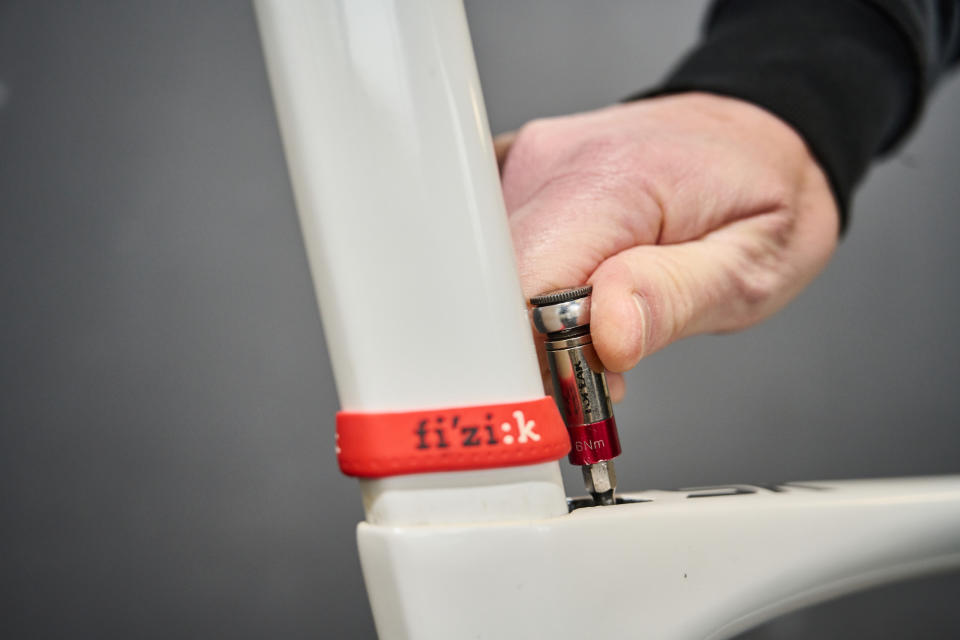
As the colours changed with every adjustment, I craved human reassurance. Riding the De Rosa out on the road, I seemed more planted, thanks to the lower centre of gravity, but being unable to stretch my legs felt odd. Was this an improvement? I needed a second opinion.
Bike fitter: the human touch
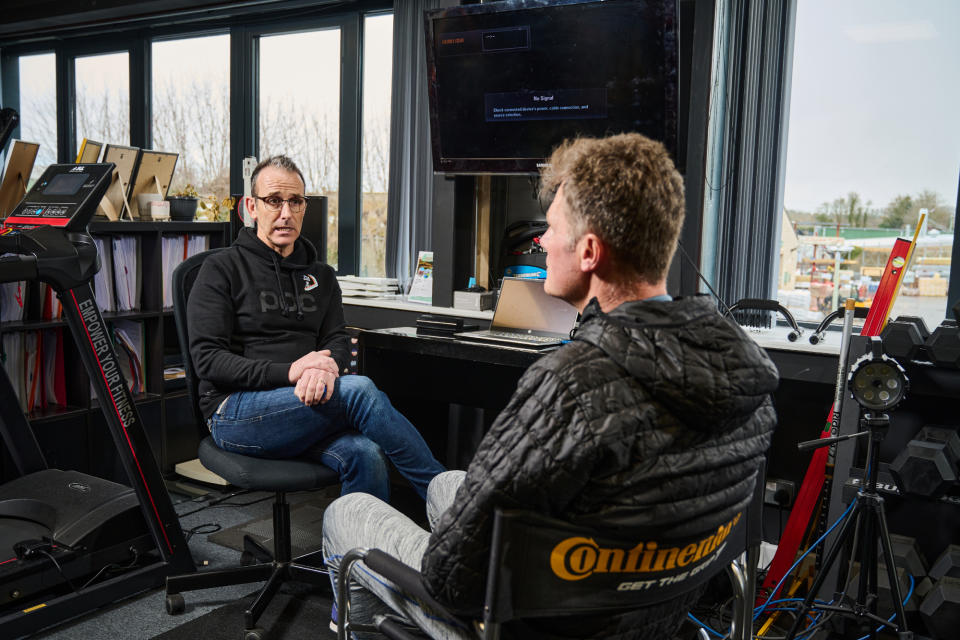
A bike-fit with Bayton at Ride 24/7 is a civilised affair that starts with a freshly brewed flat-white and a chat. The bike has been returned to its original spec, Bayton is in the dark about MyVeloFit’s recommendations and there’s no need to rearrange soft furnishings or worry about camera angles. All I have to do is hand over the £175 fitting fee.
“I want to find out why clients have taken the time to come to see me,” says a quietly spoken yet affable Bayton. “Are they experiencing some discomfort on the bike, seeking a performance gain or both?” As we chat about the style of riding I do, I notice Bayton’s eyes exploring me and my bike, searching out little clues, discovering parts – body and machine – that need attention. He’s already started to assemble the complex physiological jigsaw puzzle in his head, even though he’s yet to see many of the pieces.
Bayton then takes some key measurements, not unlike being fitted for a suit, before asking me to complete a few mobility exercises. “I ask clients to do some very basic moves,” he says. “Common issues are knee pain, lower back, neck, shoulder, hand and hip pain, all of which can point to a problem with the bike and/or with flexibility.”
After the mobility test, it’s almost time to hop on the bike, but not before Bayton has given it the once-over. “Small things like wonky saddles or crazy saddle angles are a big no-no,” he grins. “I also look for misaligned cleats, scuffs on the chainstays and unusual wear marks on the handlebar tape.”
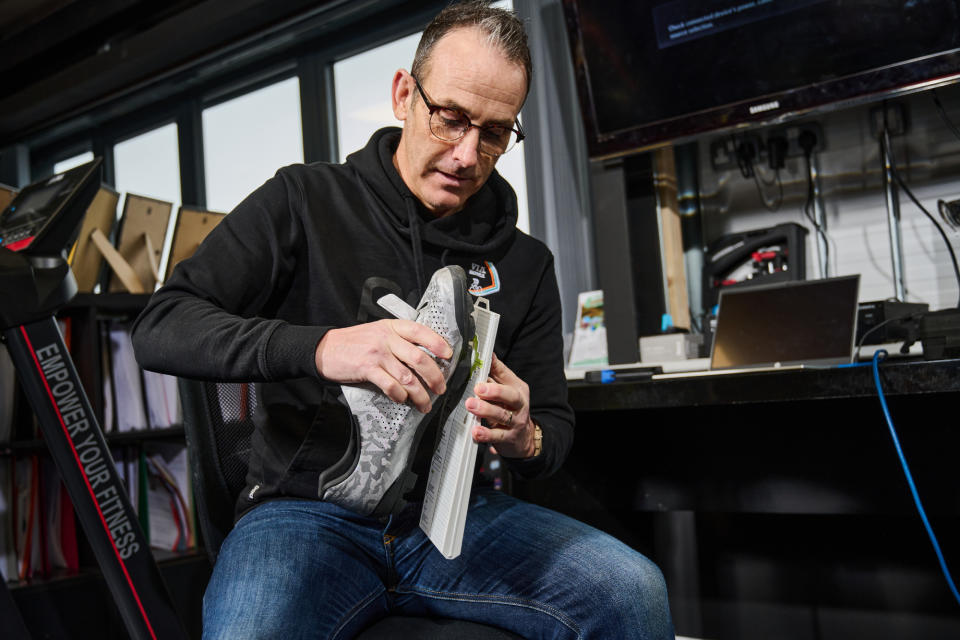
The hawk-eyed fitter notices that my hoods are positioned too far down the curve of the bars, pitching me forward. He unwinds the tape, re-fastens the hoods in a neutral position, and asks me to give them a try. Wow, what a difference this small adjustment makes; it’s only now that I notice just how much too far ‘over the bars’ I’ve been riding.
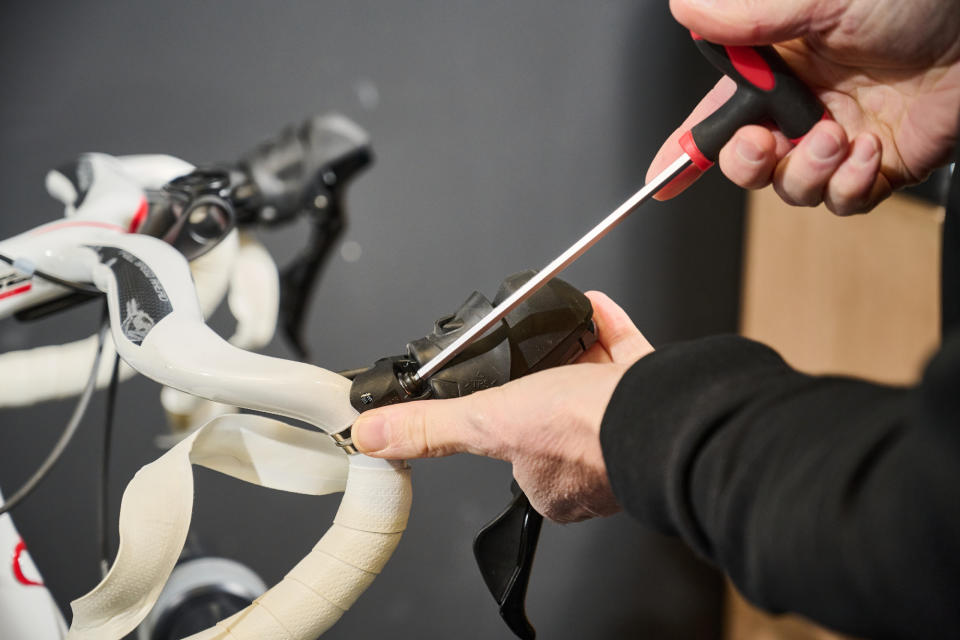
Bayton uses STT’s 2DMA 2D motion analysis bike-fit system, the kind of tech used by many WorldTour teams. It does require small, sticky reflective markers to identify key joints, but other than that it’s remarkably similar to MyVeloFit. A camera captures my movement while Bayton’s laptop analyses the footage, generating the familiar stickman overlay and a battery of data, some of which is green, some amber, some red.
I’m on a set of rollers again, but with the sensible addition of a captive front wheel. Remarkably, the STT software recommends almost the same changes, but the process is so much quicker. It takes just seconds to compute the data and thankfully there’s no endless hopping on and off the bike to edit and upload videos. In fact, other than a bit of light pedalling, sipping coffee and staring longingly at Ride 24/7’s display of Italian exotica, there’s nothing to do but sit and relax while Bayton does some occasional spannering. Which gives me the opportunity to pose plenty of questions.
I ask Bayton whether the software’s got it all wrong about my saddle height. “It’s quite common for cyclists, particularly those who started riding decades ago, to keep jacking up their saddles,” he confirms. “Lowering your saddle will allow you to release more power and, as importantly, avoid knee, hip and saddle pain.”
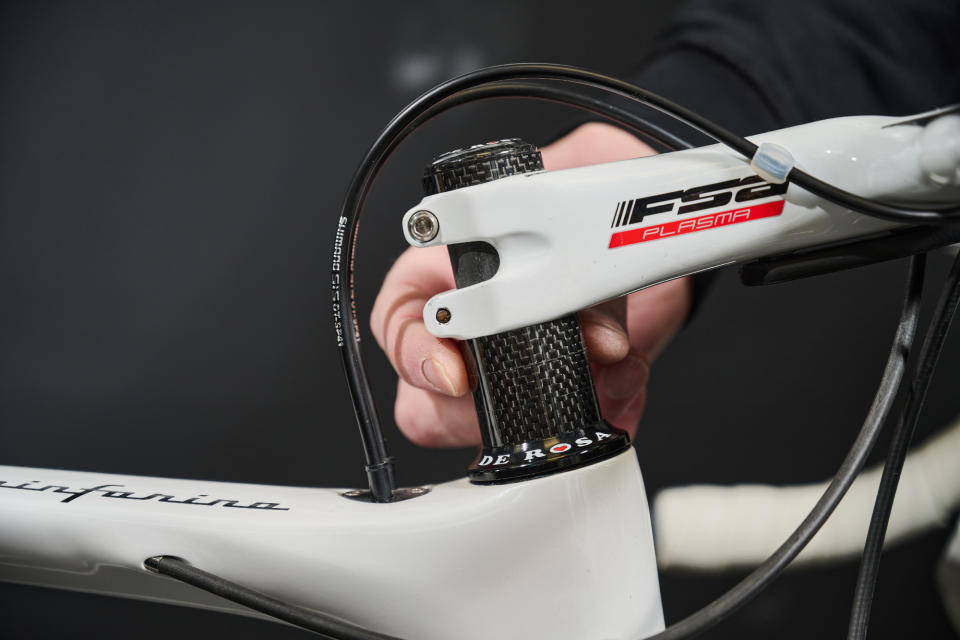
The figures also suggest that I could lose a 10mm spacer from the unsightly 30mm stack above my headset, another consequence of getting the saddle height in order. This gives Bayton the opportunity to check my position on the bars again. MyVeloFit only looks at one orientation, so although it does take stem length into account, it’s unlikely to pick up on issues such as bar width and depth. Bayton gives my integrated carbon FSA bars the thumbs-up, which is fortunate because MyVeloFit had recommended going 10mm longer on an already longish 120mm stem.
What if I was younger, more flexible and actively racing, would the entire fit be different? “Certainly,” asserts Bayton. “The figures suggested by the system are very accurate but there’s a range we can play within. If you’re mobile enough, and competitive enough, then we can experiment slightly outside that range too.” But the fact is, I’m no more competitive than Bayton’s average punter. “Most of my clients want to be able to enjoy a three-hour hilly ride in the Cotswolds with their mates, stopping for a coffee and a cake along the way. Some of them have spent a lot of money on their bikes, so getting the most out of them is important. This often means tailoring a race machine to be more forgiving.”
AI versus bike-fitter: the verdict
MyVeloFit is impressive. For a fraction of the cost of a human bike-fit, it diagnosed the problems with my original position on the bike and successfully guided me to a solution that was almost identical to the recommendations from our human fitter, Grant Bayton (see table below).
So, does that make it better value than someone like Bayton? Frankly, MyVeloFit was a faff and, for a novice like me, an unnerving experience.
To be fair, Bayton’s bike-fit was a bit of a faff too, but it was him doing all the faffing. All I had to do was drink coffee and talk bikes. The result was similar, but it’s hard to quantify the expertise and reassurance Bayton offered. He noticed details MyVeloFit can’t yet compute, such as the position of my hoods and my curious choice of pedals.
Bayton also had back-up in the shape of Dave Evans and his team at Ride 24/7. Had my De Rosa needed more drastic work than two rolls of bar tape, I wouldn’t have needed to go far. Bayton’s also on speed dial should I have issues with the bike.
Which makes Bayton better value, right? Well, yes and no. If, like me, you’re short on both time and expertise, then a human bike-fitter is worth the money. But if you’re short of cash, know your way around the human body and have an idea of how bikes are screwed together, AI has become a fitting alternative.
AI versus bike-fitter: the changes
On the road: testing the changes
I very nearly didn’t bother with a bike-fit. The only discomfort I thought I was suffering from was the uncomfortable truth that poor fitness was to blame for my lack of performance. I was wrong.
First, having a fit has cured the mental anguish that’s plagued me for decades around sizing. At 6ft 3in, I’ve always been placed on seemingly jumbo-sized frames (anywhere between 58 and 62cm, depending on the brand). Should I be riding something smaller, with faster response and lighter weight? No. Thanks to MyVeloFit and Grant Bayton, I now know my 60in De Rosa is the best size for me. In hindsight, I should have invested in a fit before spending a lot of money on a new bike. Obvious really.
My saddle was too high. MyVeloFit highlighted the fact in bright red, and Bayton confirmed it. What’s more, looking at the video playback, it’s clear that my hips were rocking more than the Isle of Wight ferry on a windy December crossing. Dropping the saddle has taken some getting used to, but it’s lowered my centre of gravity for faster, more confident cornering and has enabled me to put more power down. I’m also experiencing less saddle soreness on longer rides. Lowering the saddle brought other parts of my body into better alignment too. I’m hoping that these changes will ward off any potential physiological issues in the future.
Bayton noticed that my hoods were badly positioned; rectifying this has made a major difference to both comfort and bike-handling. Only now do I appreciate that my aching hands, wrists and neck on long rides were caused by too much weight being pitched forward.
This full version of this article was published in the print edition of Cycling Weekly. Subscribe online and get the magazine delivered direct to your door every week.

